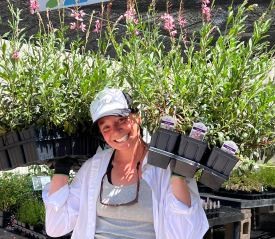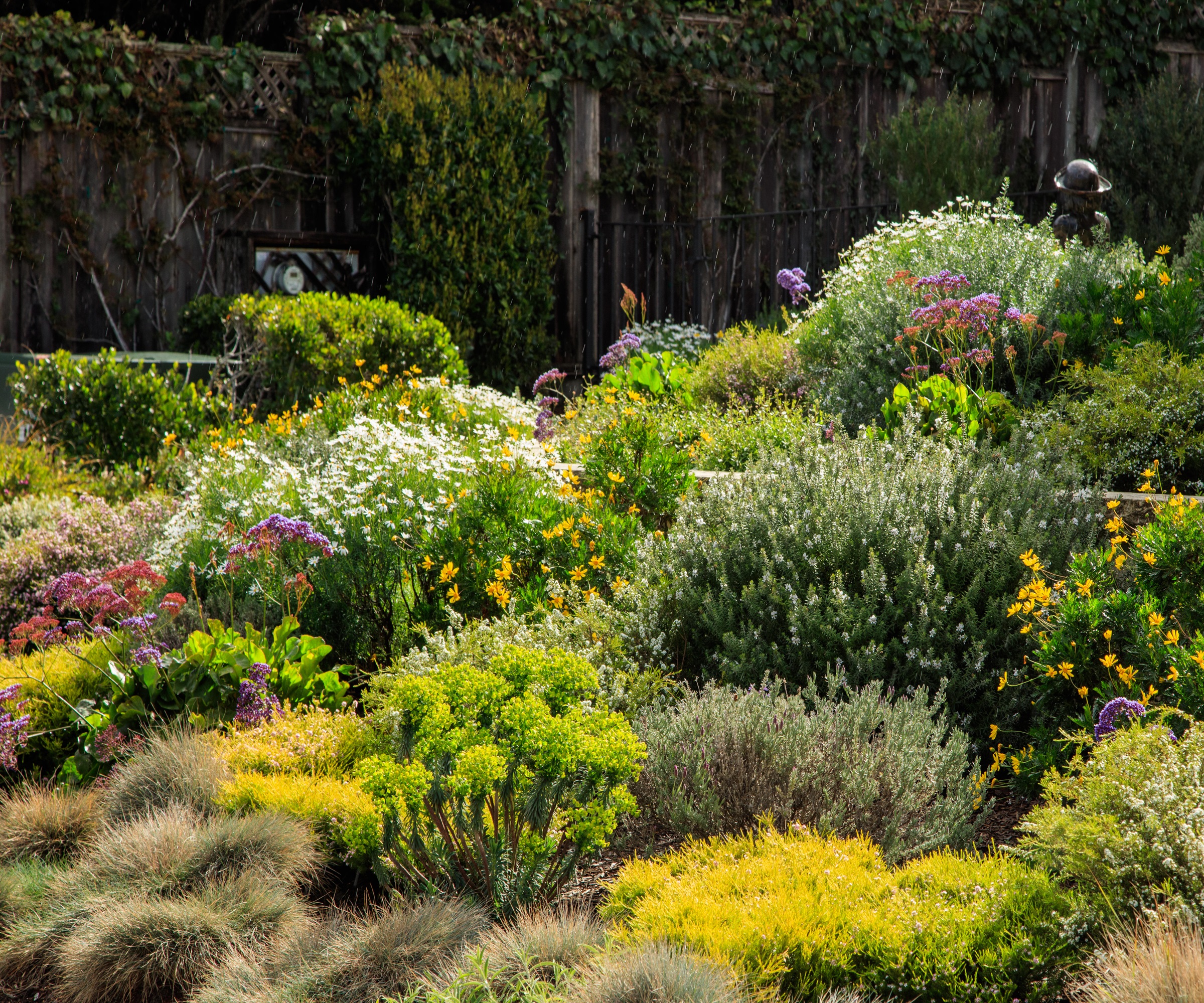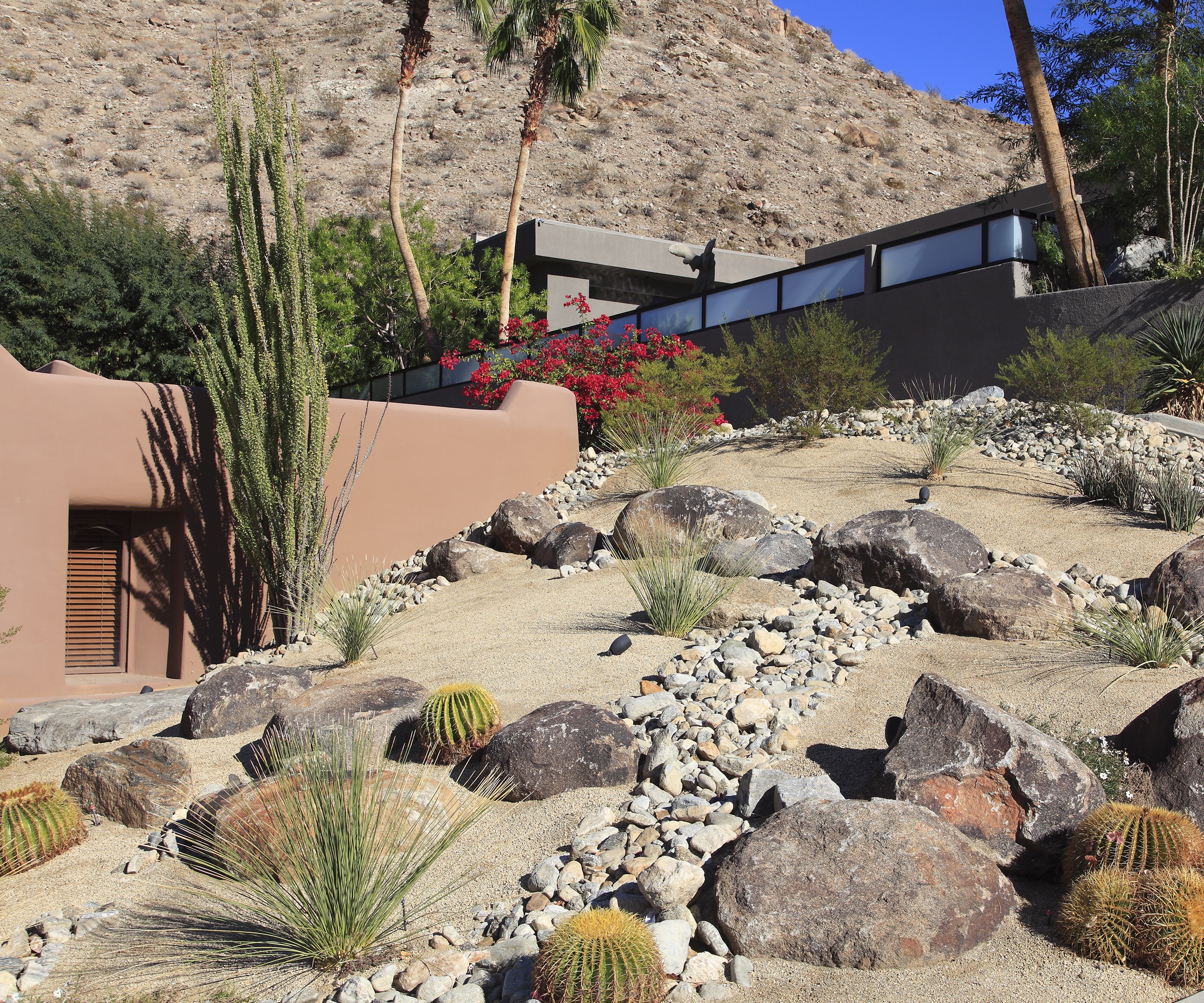Desert landscaping ideas – 12 design and planting solutions to add structure and shapes to dry gardens
Discover the top desert landscaping ideas to rejuvenate a dry, arid yard


- 1. Incorporate shade giving trees
- 2. Showcase sculptural cacti
- 3. Strike a balance with cooling plants
- 4. Include night blooming plants
- 5. Use light-colored landscaping materials
- 6. Choose the right mulch for your plot
- 7. Grow drought tolerant plants
- 8. Incorporate bermed areas for year-round interest
- 9. Showcase agaves
- 10. Grow graceful grasses
- 11. Make striking plant statements
- 12. Landscape with big and bold shapes
- FAQs
Deciding on desert landscaping ideas can appear daunting at first but, be reassured there are plenty of inspiring plant combinations, head-turning looks and design choices you can utilize to transform a hot, dusty yard.
While there may not be as many floriferous and colorful blooms to include, there are plenty of striking plant shapes, mesmerizing textures and details to play with. From sky-soaring cacti, fascinating succulents to the tactile tussocks of clump-forming drought-tolerant ground cover plants, there's plenty of scope to create a stylish and practical outside space by using clever and considered drought-tolerant planting ideas.
It also pays to think big and bold when it comes to shaping and styling your sun-soaked yard. Want to get started? Check out these expert-approved tried and tested desert landscaping ideas.

Desert landscaping ideas
We've put together 12 solutions to help all those with sunny, dry and arid yards. So, whether you're searching for desert front yard landscaping ideas or looking for ideas for south-facing gardens, our comprehensive list will have all the information you need.
1. Incorporate shade giving trees

Mature trees are dramatic and revered features of any desert landscape. Often standing alone, set against the horizon or barren surroundings, they make striking sculptural statements and provide shelter for birds and wildlife, as well as casting valuable shade.
If you are lucky enough to have existing trees on your plot, ensure they are well looked after and design your landscape around them. if you are starting a garden from scratch, make sure to include a few fast-growing trees in your design.
‘Leave room for lots of tall trees which can protect living areas from the heat,’ says Elliot Rose Owner & Founder of Wildwood Landscapes, ‘Consider acacias, mimosas, arbutus, desert willows, certain magnolias, or melaleucas, all considered some of the best trees for shade, which can grow quickly to provide a shady canopy.’
Design expertise in your inbox – from inspiring decorating ideas and beautiful celebrity homes to practical gardening advice and shopping round-ups.
Southern magnolia trees are available to order online from Walmart.
2. Showcase sculptural cacti

With their iconic shapes and bold silhouettes, cacti are synonymous with dry, arid landscapes and suitable for those gardeners living in southern regions like US hardiness zone 10. One of the best desert plants to grow, they can make a fun, visual statement in any part of the yard.
Grow small specimens in containers, for extra emphasis, and group together in a courtyard or alongside an entranceway if you want to create a contemporary feel. Taller species – such as the Organ Pipe and Candelabra – can be dramatically framed against a smooth rendered wall.
‘If our clients desire a more modern desert garden, I like to focus on the sculptural cacti plantings, often highlighting and surrounding them with sprawling ground covers,’ adds Elliot. ‘Cacti can be used as centerpieces in a border or also planted closely together to create a structure such as a border or wall.’
The statuesque fairy castle cactus, available from Walmart, makes a striking focal point, while the potted pencil cactus, also available from Walmart will cast a much finer silhouette.
3. Strike a balance with cooling plants

Plants have many practical uses including providing food and shelter for wildlife, binding crumbling banks and improving soil health, plus helping to protect outside areas from wind, sun and rain.
They can also have a cooling effect too, as Elliot Rose explains. ‘Plants themselves reduce the surrounding air temperature through evapotranspiration, so in general the more planting the better. For ground covers we love using sedum varieties - such as Angelina and Blue Spruce; Myoporum if we are after a more succulent look, or Dymondia and Creeping Thyme varieties if we are after a softer look.’
He also adds that, ‘Dymondia, commonly known as the ice plant, can also make a great full sun ground cover plants to use as a lawn alternative, walking path, or surrounding flagstone pieces in a pathway.’

Growing up in Marin County, Elliot worked alongside his father who owned a construction business that operated throughout the Bay Area. Following his college studies in landscape design and horticulture, he went on to open a commercial aquaponics farm in Half Moon Bay, which eventually led to his career in landscaping. At a local high-end design and build firm, Elliot served as a construction foreman and assistant designer until he opened Wildwood Landscapes. Elliot continues to bring his passion for design and strong technical construction background to every project, leading clients from the initial site-visits to the polished installation.
4. Include night blooming plants

Make your evenings more pleasurable by growing drought-tolerant plants that release their fragrance after dark.
‘In areas close to the house or along paths, I love to incorporate night-blooming plants like stomatiums or evening primrose, Oenothera fremontii ‘Shimmer’, which will enhance backyard pollinator resources into the evening and set the stage for late summer outdoor dinners,’ says horticultural expert, Lauren Carvalho.
Other scented twilight beauties include dianthus with its clove-scented floral rosettes, the annual tuberose and the spectacular angel’s trumpet, with its shapely hanging blooms. If you find yourself enchanted by these perfumed night stars, consider creating a moon garden, perfect for a spot of restful stargazing.
Dianthus plants are available from Walmart.

Growing up the daughter of a landscape designer, Lauren was often a-tag-a-long to job sites and wholesale nurseries, while chores at home included A LOT of weeding. Although it began as childhood drudgery, working with plants has become the focus of Lauren’s adulthood and career. Beginning as an organic produce farmer in the Southwest, she developed a fascination with reducing the use of pesticides through using beneficial insects. This led to a life-altering opportunity learning to propagate native and pollinator-friendly, habitat-providing plants. Currently, Lauren is working with High Country Gardens and some of the brightest thought leaders in Western Horticulture.
5. Use light-colored landscaping materials

Reflect the sun’s rays and reduce retained heat by opting for paler tones in your yard’s hard landscaping. Whether for paving, walls, gravel gardens or pool coping, these light, bright tones will contribute to lower temperatures and strike a timeless style note too, perfect for any modern backyard project.
‘In hot dry climates it’s important to use light-colored paving surfaces,’ says San Francisco-based, landscape designer Elliot Rose.
‘In general, we avoid dark colors or dense materials such as concrete. It’s good to consider using breaks of materials, groundcovers, or softer materials which won’t act as a heat sink.’
6. Choose the right mulch for your plot

In dry climates, mulch is key to retaining moisture and keeping soil temperatures consistent, but not all mulches are created equally. ‘Wood or bark-based mulches aren’t always great for desert landscapes,’ says Lauren Carvalho.
‘Instead, opt for crushed gravel mulch, like crusher fines or expanded shale. These mulches will knit together better than a rounded stone like pea gravel, and provide superior protection for dry planting.’
While it is common practice to lay landscaping fabric down as a weed barrier, before topping it with aggregate, Lauren has a word of caution. ‘Avoid using weed barrier cloth in garden beds, while it might prevent the emergence of weeds, it often restricts water from reaching your plants and heats the ground.’
Pointing paving slabs is another important detail to consider. ‘If you are thinking of creating a patio in your outdoor space, make the cracks between materials natural and permeable, instead of solid options like concrete,’ continues Lauren.
Doing so will ensure that 'precious water is absorbed back into the aquifer rather than wasted through run-off or evaporation.’ Just one of many xeriscaping ideas that might seem small, but can have a big impact.
7. Grow drought tolerant plants

It sounds obvious, but the gardening principle of ‘right plant, right place’ is particularly important in hot, dry zones.
Master gardener Tabar Gifford explains, ‘There is no need to remove all living things to save water, but by xeriscaping your yard, you can make a beautiful, blooming, resilient landscape. Designing your space with resource conservation in mind will save water, while also supporting healthy soil, pollinators, birds and other wildlife.’
When it comes to choosing ground cover plants there are many options. Tabar says, ‘personal favorites of mine for hot dry climates include ice plants. You may think these plants prefer cold climates, however they tolerate the extreme heat and cold you’ll find in the desert and high elevations. They also thrive in poor, infertile, well drained soils, making them a must have for desert landscaping.’
While cacti and succulents are some of the more obvious - and visually dramatic - desert thriving plants, there are other lesser known choices too.
'You may be surprised to learn that some of the more fragile looking plants also prefer these harsh and challenging growing conditions,' says Tabar. One option is agastache, available from Walmart. 'There are many types of agastache, also known as hummingbird mint, with impressive forms and colors, and these beauties love the poor soil conditions of a desert landscape.'

As the Customer Experience and Partnership Cultivator at American Meadows, Tabar Gifford, is a Master Gardener and dedicated 'plant geek'. With a lifelong love for gardening and nature, and a background in environmental studies and sustainable community development, she combines horticultural expertise with a commitment to education. Striving to empower individuals in achieving their gardening aspirations, Tabar embodies a genuine passion for sharing her knowledge.
8. Incorporate bermed areas for year-round interest

Building up areas of a hot and dry garden is an artful design trick that adds interest and form to landscapes. A simple mound of soil, often incorporating boulders, rockeries and gravel, can create a natural-looking, undulating terrain that accentuates its surroundings and architecture.
These manmade features are also useful for guiding stormwater to where its needed most. For instance, berms, as these mounds are called, can be built around trees or shrubs, not only to highlight their form but also to guide water to the roots rather than simply running away.
Planting up a berm with smaller succulents, such as echeveria, haworthia and sempervivum, is a great way to show off their intricate forms and leaf tones. Intersperse them with rivers of pebbles and rocks for a contrast of textures. Sempervivum plants are available from Walmart.
Introducing these earthy mounds to your yard is also great way to frame your home's entrance and create subtle garden screening.
9. Showcase agaves

No desert landscaping is complete without agave plants. With over 300 species available – in all shapes and sizes – there’s a huge choice for beds, pots and standalone statements.
Native to Mexico, the Caribbean and southern states, these architectural plants have thick, fleshy leaves often feature spines, ribs or super smooth surfaces.
Hailing from hot, dry climates, good drainage is essential if these plants are to survive, as they will not tolerate any root rot or pooling water. A top designer choice for planting around a pool, they look particularly spectacular when in flower.
The Fox tail agave produces long arching flower stalks, is deer resistant and can reach heights of up to 5ft (1.5m), while the blue glow agave, available from Nature Hills, has inward curving leaves in a shimmering shade of silver-blue.
10. Grow graceful grasses

Knowing how to grow ornamental grasses is a real asset when it comes to planting up a drought tolerant landscape. Adding height, movement, texture and subtle tones, there are many varieties that thrive in hot, sunny positions.
Requiring very little attention, they happily intermingle with a wide range of plants, from flowering sedum, mallow and mullein to more architectural statements including agave, aloes and cacti.
When selecting ornamental grasses for your arid yard, decide on which shape grass works best for your location. Clump forming festuca, for example, will add blue mounds to your yard and are great plants for edging paths. Be sure to check out ice blue festuca, available from Nature Hills, famed for its tall, powdery blue foliage.
Mexican feather grass has tall, wispy sun bleached seedheads that blurs beautifully with gravel and crushed rock while the bold, broad red blades of Japanese blood grass are instant head turners against a wall.
11. Make striking plant statements

Planting on mass is another simple way to create impact. Repeating a group of the same clump forming grass across a specific area will magnify the grass’ natural tone and texture as well as acting as protection for other plants.
Selecting drought tolerant plants for pots is another fail safe way to make an impact. Go for a eye-catching single specimen, such as agaves, or alternatively opt for filling a container with a single plant type. Sempervivums and echeverias are ideal and it’s also a clever way of raising up these smaller more intricate plants to make them easier to appreciate. Planting on mass will undoubtedly add impact.
12. Landscape with big and bold shapes

Desert landscaping ideas work best when they are bold and impactful. Remember, fortune favors the brave. As these yards often feature large expanses of aggregate, paving and boulders it’s important that any planting or design features are in proportion to avoid looking twee, fussy or out of place.
A majestic boulder can be beautifully complemented with a single, stately agave whereas against a mass of smaller succulents the overall look can be messy and insignificant.
Dry rivers - gullies arranged and filled with rocks, stones and scree - can help draw th eye, helping to frame the house and front entranceway. Natural looking berms, sunken firepits and snaking lines of boulders also work seamlessly.
FAQs
What are the best desert shrubs to grow?
While there are many flowering shrubs for full sun positions, plants that thrive in desert landscapes must cope with searing heat during the day and cool night temperatures. These tough and robust plants have evolved to manage with little water, often conserving moisture within their stems, leaves or roots, and to reflect sunlight, slowing evaporation. Choose carefully for your sun-baked plot and you can fill your outside space with sculptural shapes, tactile foliage and surprising bursts of colour.
A common indication of a sun loving flora is those plants with silver foliage. Mazanita, yucca and the Western redbud are all Californian natives and ideal for creating shade and impact.
For ground cover, ornamental grasses such as festuca will add texture and movement, while scrub plants such as verbascum, narrow-leaf milkweed and desert mallow will add color.
Looking for more inspiration for your desert yard? Check out the latest xeriscaping techniques to try and discover the best front yard rock landscaping ideas to shape your home’s exterior.

Journalist Jill Morgan has spent over 20 years writing and editing gardening, interior and property features. Titles she has worked on include The English Home, House Beautiful, Ideal Home, Houzz and Modern Gardens and she writes regularly for H&G as a Contributing Editor. Whilst she is a dab hand at renovation projects and DIY, she is happiest when out digging in the garden or planning a new border.
